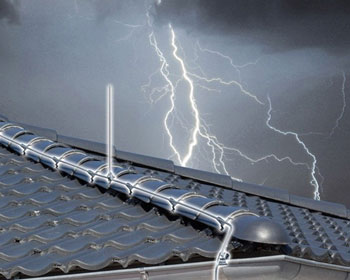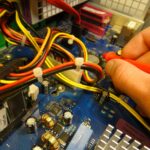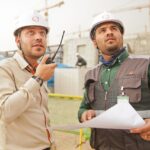Earthing Services
Before an electrical earthing / grounding system can be installed a few other activities must first be undertaken. Historically installation companies may have offered to drive a single earth rod and take a range of readings from it at various depths as it is driven in to the ground. To say that this is better than nothing, or a reasonable compromise, is comparable to saying that keeping your fingers crossed will ensure that you win the national lottery.
The only thorough, scientific and logical method of determining an electrical earthing system is to undertake a complete soil resistivity survey to an approved methodology. Earthing Services does not endorse anything other than the professional approach when obtaining information that will provide the basis for decisions on electrical earthing systems. The importance of this variety of life saving, critical safety system, demands that determinations on requirements are based upon accurate, meaningful and useful data, which is exactly what Earthing Services provides.
Harnessing the wealth of information about the electrical behaviours of soil masses throughout the globe enables Earthing Services to bring that knowledge to contribute to the analysis of each new project. Earthing Services calls upon its database of soil models, along with first hand experience of the geology of an area, including the influences of seasonal variations in climate, to make astute soil profiling decisions about its customers’ projects.
Earthing Services engineers undertake soil resistivity surveys for numerous customers on a regular basis, and these services have been conducted all over the world. Feedback from a number of new customers (who have previously subcontracted soil resistivity surveys to other companies), has brought to our attention that Earthing Services’s turnaround time from the commencement of testing to the client’s receipt of processed results is faster than competitors by a considerable margin.
The speed with which Earthing Services is capable of obtaining data from site and computing it is largely down to the combination of motivated, trained, and incentivised staff, and state of the art methods of capturing and transmitting data from site to the servers at the Nottingham office. Incoming data is planned and it is normal practice for an engineer to be primed for the information to arrive so that no time is lost in converting the raw statistics into meaningful results. When it comes to effectiveness Earthing Services ticks all of the boxes, from cost efficiencies all the way to providing the processed results within a time efficient duration.
Planning and Geographic Determinations
From the moment the company receives an order which requires a soil resistivity survey Earthing Services engineers commence the desktop planning stage of the project. Our trained team knows how to assess the practicality and usefulness of a given area when it comes to undertaking soil resistivity surveys, and this can begin using topographical data, location coordinates, and plotting technologies.
A single “run” or collection of soil resistivity data requires approx. 170m of uninterrupted open land (soil-type ground mass), and this enables the engineers to assess the electrical resistivity attributes of the ground to a depth of over 50m. It is usual that the lower the depths, the more stable and generally better, the electrical resistivity performance. In the event that less land is available it is not uncommon to do shorter (and therefore shallower) soil resistivity surveys, however this results in a less exhaustive dataset. Due to the specific geographic requirements for undertaking soil resistivity surveys there are occasions where this is unavailable at the project site and alternative locations have to be used.
Despite these seemingly stringent constraints due to Earthing Services’ commitment to its customer base, the company’s engineers have always obtained accurate, meaningful, data that will capture the sub-surface electrical characteristics of a site. The company is able to do this based upon knowledge of the stability and greater uniformity that lower depths offer across larger distances and of a knowledge that Earthing Services has a reputation built upon maintaining an excellent standard of service to its clients that demands the harvesting of a meaningful, useful data set. The initial desktop survey enables a decision to be made about testing locations in advance as well as strategic “back up” sites in the event that the primary locations are unavailable.
Earthing Services is a rarity in its thoroughness with this aspect of planning, but this contributes to the success the company enjoys in terms of its performance. Clients are safe in the knowledge that if Earthing Services engineers attend a site they are going to be trained, experienced, well-briefed, and focused on achieving the common goal of obtaining a useful, and meaningful data set.
Audits, Testing & Commissioning
Expertise is hard earned and when it comes to electrical safety systems of any variety it is important to have people who know what they are doing. Earthing Services engineers are often sought to oversee or intermittently audit the ongoing effectiveness of electrical earthing systems. Other times Earthing Services is required to validate the works that other companies have undertaken to ensure that it meets with the requirements of a design or specification. Testing and commissioning services are generally required at the end of an installation project and in many instances where Earthing Services has provided design and specification services the company’s engineers return to site and ensure that performance has been achieved to enable a DNO to power or energise a site.
Development of Task Specific Documentation
Earthing Services engineers can draw on their decades of construction and power knowledge when visiting a site, but this has to be supported by site specific documentation containing the outputs of the various plans made in advance of site attendance. Audits regularly require lateral thinking and responding meaningful to evidence on site and as such the site documentation may not be exhaustive in its order of approach, however it shall contain all necessary plans and health and safety information to enable the operatives behave in an appropriate manner, and for customers to be safe in the knowledge that the engineers are acting responsibly.









